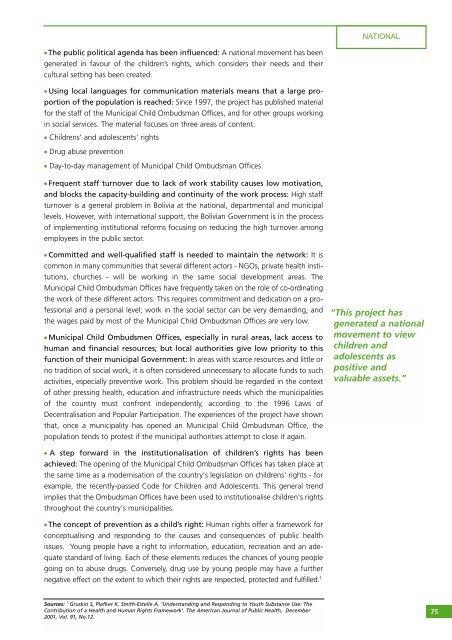PDF (Lessons learned in drug abuse prevention: a global review)
PDF (Lessons learned in drug abuse prevention: a global review)
PDF (Lessons learned in drug abuse prevention: a global review)
You also want an ePaper? Increase the reach of your titles
YUMPU automatically turns print PDFs into web optimized ePapers that Google loves.
NATIONAL<br />
● The public political agenda has been <strong>in</strong>fluenced: A national movement has been<br />
generated <strong>in</strong> favour of the children’s rights, which considers their needs and their<br />
cultural sett<strong>in</strong>g has been created.<br />
● Us<strong>in</strong>g local languages for communication materials means that a large proportion<br />
of the population is reached: S<strong>in</strong>ce 1997, the project has published material<br />
for the staff of the Municipal Child Ombudsman Offices, and for other groups work<strong>in</strong>g<br />
<strong>in</strong> social services. The material focuses on three areas of content:<br />
● Childrens' and adolescents' rights<br />
● Drug <strong>abuse</strong> <strong>prevention</strong><br />
● Day-to-day management of Municipal Child Ombudsman Offices.<br />
● Frequent staff turnover due to lack of work stability causes low motivation,<br />
and blocks the capacity-build<strong>in</strong>g and cont<strong>in</strong>uity of the work process: High staff<br />
turnover is a general problem <strong>in</strong> Bolivia at the national, departmental and municipal<br />
levels. However, with <strong>in</strong>ternational support, the Bolivian Government is <strong>in</strong> the process<br />
of implement<strong>in</strong>g <strong>in</strong>stitutional reforms focus<strong>in</strong>g on reduc<strong>in</strong>g the high turnover among<br />
employees <strong>in</strong> the public sector.<br />
● Committed and well-qualified staff is needed to ma<strong>in</strong>ta<strong>in</strong> the network: It is<br />
common <strong>in</strong> many communities that several different actors - NGOs, private health <strong>in</strong>stitutions,<br />
churches - will be work<strong>in</strong>g <strong>in</strong> the same social development areas. The<br />
Municipal Child Ombudsman Offices have frequently taken on the role of co-ord<strong>in</strong>at<strong>in</strong>g<br />
the work of these different actors. This requires commitment and dedication on a professional<br />
and a personal level; work <strong>in</strong> the social sector can be very demand<strong>in</strong>g, and<br />
the wages paid by most of the Municipal Child Ombudsman Offices are very low.<br />
● Municipal Child Ombudsmen Offices, especially <strong>in</strong> rural areas, lack access to<br />
human and f<strong>in</strong>ancial resources; but local authorities give low priority to this<br />
function of their municipal Government: In areas with scarce resources and little or<br />
no tradition of social work, it is often considered unnecessary to allocate funds to such<br />
activities, especially preventive work. This problem should be regarded <strong>in</strong> the context<br />
of other press<strong>in</strong>g health, education and <strong>in</strong>frastructure needs which the municipalities<br />
of the country must confront <strong>in</strong>dependently, accord<strong>in</strong>g to the 1996 Laws of<br />
Decentralisation and Popular Participation. The experiences of the project have shown<br />
that, once a municipality has opened an Municipal Child Ombudsman Office, the<br />
population tends to protest if the municipal authorities attempt to close it aga<strong>in</strong>.<br />
“This project has<br />
generated a national<br />
movement to view<br />
children and<br />
adolescents as<br />
positive and<br />
valuable assets.”<br />
● A step forward <strong>in</strong> the <strong>in</strong>stitutionalisation of children’s rights has been<br />
achieved: The open<strong>in</strong>g of the Municipal Child Ombudsman Offices has taken place at<br />
the same time as a modernisation of the country's legislation on childrens' rights - for<br />
example, the recently-passed Code for Children and Adolescents. This general trend<br />
implies that the Ombudsman Offices have been used to <strong>in</strong>stitutionalise children's rights<br />
throughout the country's municipalities.<br />
● The concept of <strong>prevention</strong> as a child’s right: Human rights offer a framework for<br />
conceptualis<strong>in</strong>g and respond<strong>in</strong>g to the causes and consequences of public health<br />
issues. Young people have a right to <strong>in</strong>formation, education, recreation and an adequate<br />
standard of liv<strong>in</strong>g. Each of these elements reduces the chances of young people<br />
go<strong>in</strong>g on to <strong>abuse</strong> <strong>drug</strong>s. Conversely, <strong>drug</strong> use by young people may have a further<br />
negative effect on the extent to which their rights are respected, protected and fulfilled. 1 75<br />
Sources: 1 Grusk<strong>in</strong> S, Plafker K, Smith-Estelle A. ‘Understand<strong>in</strong>g and Respond<strong>in</strong>g to Youth Substance Use: The<br />
Contribution of a Health and Human Rights Framework’. The American Journal of Public Health, December<br />
2001, Vol. 91, No.12.
















